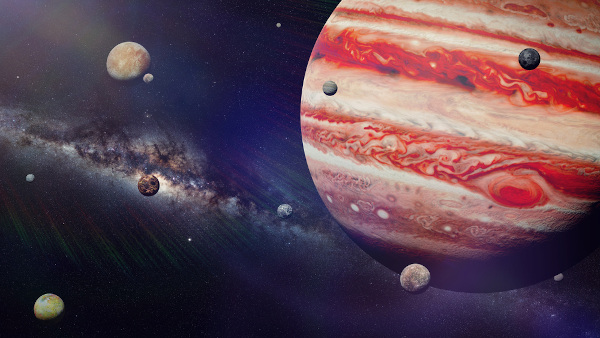Jupiter General facts about Jupiter
-
Equatorial diameter: 142,984 km
-
Surface: 6.14×10 10 km 2
-
Mass: 1.899×10 27 kg
-
Distance from Sun: 778,330,000 km
-
Natural satellites: estimated to have between 60 and 70 known satellites, four of which have been dubbed “Galilean moons” since their discovery in 1610 by Galileo Galilei: Ganymede, Callisto, Io and Europa. The first is slightly larger than Mercury, and the other three are similar to our Moon.
-
Rotation period: about 10 hours
-
Period of translation: approx. 12 years
-
Average temperature: -121. 1°C
-
Atmospheric composition: Jupiter’s atmosphere is essentially made up of two gases: 86%hydrogen and 14%helium, with minor amounts of methane, ammonia, water vapour and hydrogen sulphide.
 Because of its size, Jupiter has many satellites.
Because of its size, Jupiter has many satellites.Jupiter’s importance
Almost all the planets in the solar system are named after gods from Roman mythology, which is very similar to Greek mythology. For the Romans, the god Jupiter would be the god of gods, as Zeus is for the Greeks, and the son of Saturn, who would be Kronos in Greece.
Jupiter owes his name to the fact that he is the largest of the planets, reigning as it were over the others.
Features
Jupiter’s features are as colossal and impressive as the planet itself. Visible features include the colorful clouds that hover over its surface, due to the composition of the atmosphere (hydrogen and helium) and the intense storms that occur there, with winds of up to 600 km/hr. The most famous cloud has been named the Red Spot, so large that it is capable of covering the entire Earth.
These storms are common on Jupiter, a gaseous planet with a hydrogen-rich atmosphere. Studies show that some storms last a few hours, others centuries, and can be fatal to humans.
 The colors of this planet can be a sign of major storms.
The colors of this planet can be a sign of major storms.Jupiter ‘s magnetic field is much stronger than that of the Earth. This fact may help us understand the large number of natural satellites in its orbit.
The planet’s internal structure is still unknown, but studies point to a solid, rocky or even icy core, which would explain the planet’s immense gravitational force.Surrounding the core is the mantle, which contains dense metallic hydrogen. Probe-based studies suggest that the temperature at the boundary between core and mantle is 35,000°C.
At the surface, there is a mixture of liquid and gaseous hydrogen, extending from the clouds (which can be seen) to a depth of around 1,000 kilometers.
See also: 8 facts about the solar system
Its famous rings
Jupiter also has rings. They are not like those of Saturn, which is the great exponent of this planetary feature, but they have been observed by probes that have visited the solar system giant.
Discovered by the Voyager 1 probe in 1979, Jupiter’s rings are composed of cosmic dust orbiting the planet. In comparison, Saturn’s rings are made of ice, so they radiate light and are visible from a great distance.
According to scientists, Jupiter’s rings are formed by meteorite collisions with the planet’s natural satellites, particularly the Galilean moons, during which fragments of the satellites are ejected and attracted by Jupiter’s enormous gravitational force, entering its orbit.
facts about jupiter
Let’s take a look at some interesting facts about the solar system’s largest planet.
-
If we lived on Jupiter, we’d have a birthday every 12 years, the time of the planet’s translation.
-
On Jupiter, the day lasts 10 hours.
-
Europa, one of the Galilean moons, may have a liquid ocean on its surface.
-
Winds of 600 km/h are common on Jupiter.
-
Jupiter’s mass is 2.5 times greater than that of the seven other planets in the solar system combined. A giant.
-
If Jupiter’s interior were hollow, it would contain 1,300 Earthlings.
-
Jupiter has the fastest rotation speed of any planet in the solar system.
-
The gravitational force on Jupiter is 22.9 m/s², compared with 9.8 m/s² on Earth.
-
Since the 1970s, seven probes have visited Jupiter:
– Pioneer 10 (1973)
– Pioneer 11 (1974)
– Voyager 1 and Voyager 2 (1979)
– Galileo (1995)
– New Horizons and Cassini (2000s)
By Átila Matias
Professor of Geography

